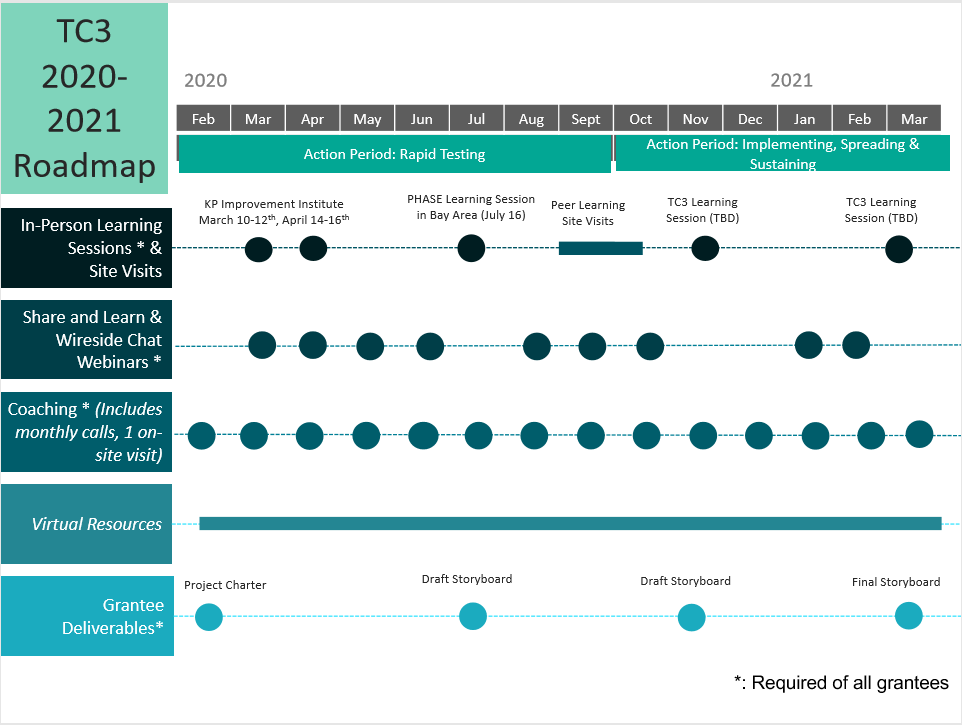
In 2003, Kaiser Permanente initiated a program called ALL (Aspirin, Lisinopril, and a Lipid-lowering medication protocol) to reduce cardiovascular disease (CVD) for patients with diabetes and/or coronary artery disease. The effectiveness of the program led several Kaiser Permanente Regional Community Benefit offices to support the translation of this program to local safety net providers, including the Preventing Heart Attacks and Stroke Everyday (PHASE) program in Northern California.
This latest cycle of this initiative will engage technical assistance and evaluation partners as the Support and Learning Team. The Support and Learning Team will provide a structured approach to technical assistance to meet the needs of grantees and clinic sites with varying levels of capacity and experience implementing population health management programs.
We have updated the TC3 roadmap to highlight what teams can expect from the program structure and deliverables in 2020-2021. Download here.
Learning Sessions & Site Visits: Some of you elected to participate in the KP Improvement Institute, which will complement your TC3 CVD work. We’re inviting you to participate in a combined TC3/PHASE in-person learning session in July, and will have two more TC3-only learning sessions later in the program. Peer learning site visits will happen in the fall. More details on all these events will be provided over the coming months.
Webinars: We’ve mapped out a schedule for roughly monthly webinars that will complement your individual coaching with Denise. These webinars will be structured to provide content as well as foster peer-to-peer learning across the TC3 collaborative. We’ll work with you to schedule these so that representatives from each team are available to attend.
Coaching: Your monthly coaching calls with Denise will continue. She will also visit your sites in-person later this year.

Grantee Deliverables: In advance of each in-person learning session we’ll share a template for your team to complete a storyboard that outlines the progress of your project. These storyboards will be shared at the learning sessions as a way to provide updates on your progress to your co-TC3 teams, as well as solicit feedback. Your team will present a final end-of-project storyboard at the last in-person session.
 A core expectation of the program is participating in monthly coaching to advance the progress of your projects. Denise Armstorff is the coach for all TC3 teams.
A core expectation of the program is participating in monthly coaching to advance the progress of your projects. Denise Armstorff is the coach for all TC3 teams.
Denise has worked for over 30 years in the healthcare industry and in the arena of performance improvement since 2008.
How coaching will support you:
Project Portfolio
| Project Portfolio Template | Download Template Spreadsheet by clicking here |
Project Charter
| Project Charter Template | Download Word document by clicking here |
| Project Charter Tutorial | Download Word document by clicking here (or view PDF) |
PDSAs
| PDSA Worksheet Template | Download Word document by clicking here (view PDF) |
| PDSA Worksheet Example | Download Word document by clicking here (view PDF) |
| PDSA Tracker Template | Download Word document by clicking here (view PDF) |
| PDSA Tracker Example | Download Word document by clicking here (view PDF) |
The program officially launched on May 2, 2019. We covered:
Download slides below and view the recording to the right.
The refreshed approach looks to build off of a decade of work in the safety net. While many tenets will remain the same, there are a few changes from the last cycle, which include:
In addition, the Support and Learning Team will work to assist grantees with data reporting, validation, and visualization by:
This initiative has four key goals: